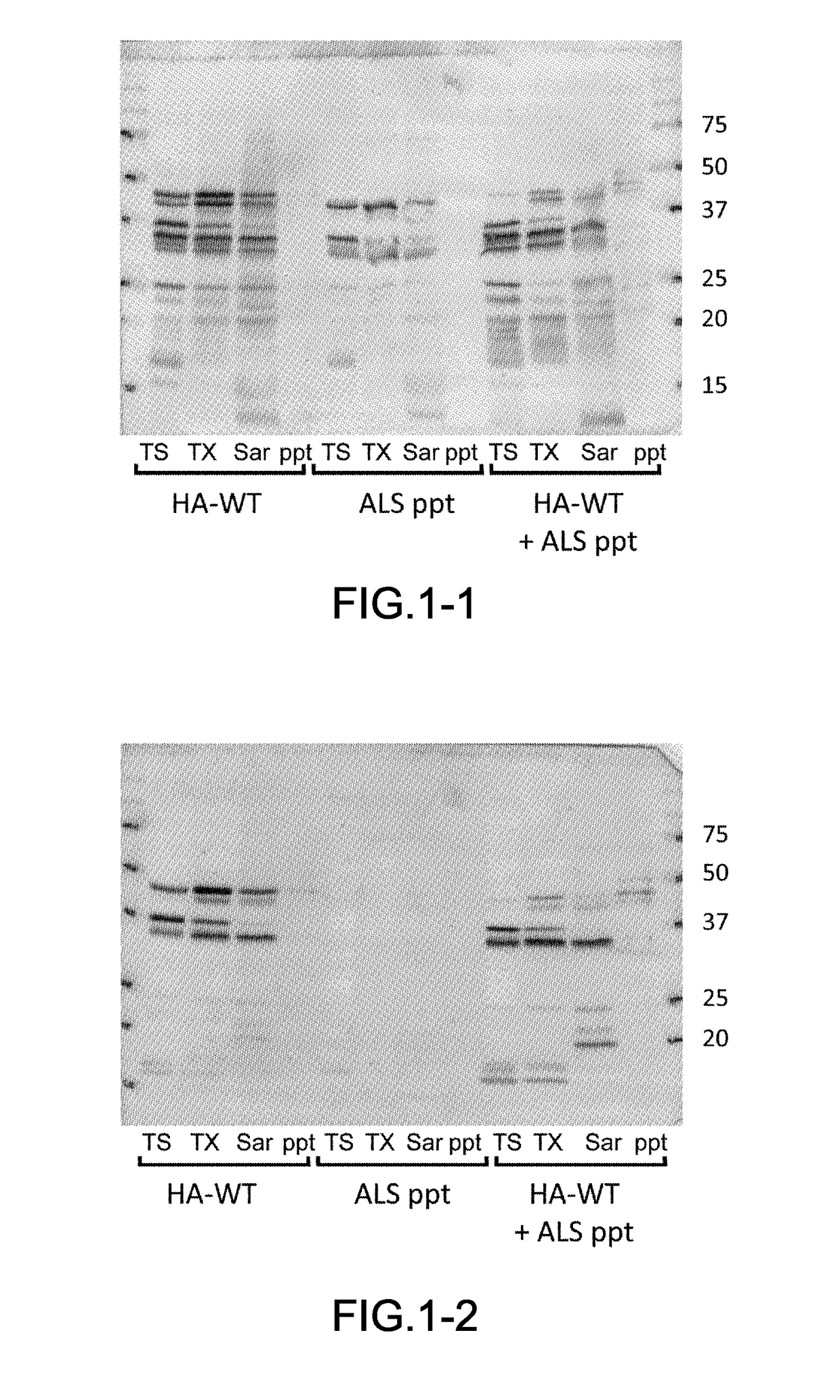Method for producing insoluble aggregate of neurodegenerative-disease-related protein
a neurodegenerative disease and insoluble aggregate technology, applied in the field of producing an insoluble aggregate and an insoluble aggregate of human neurodegenerative disease related protein, can solve the problem that no aggregate observed in the brain of patients can be formed at all
- Summary
- Abstract
- Description
- Claims
- Application Information
AI Technical Summary
Problems solved by technology
Method used
Image
Examples
example 1
1. Materials and Methods
1.1 Harvest of Samples
[0053]The following experiments in these examples were performed based on an approval of research ethics committee of Tokyo Metropolitan Institute of Medical Science (the former Tokyo Institute of Psychiatry) (approval number: 17-36, approval date: 2005.9.3).
1.2 Preparation of Insoluble Fractions from Brain Samples
[0054]The frozen brain samples harvested from the patients (0.5 g) were homogenated in five times its volume of A68 buffer (10 mM Tris (pH7.5), 0.8 M NaCl, 1 mM EGTA, 1 mM DTT) and their suspensions were prepared. N-sodium lauroyl sarcosinate was added to the suspensions at a final concentration of 1% and incubated at 37° C. for 30 min. The suspensions were centrifuged (12,000×g, 10 min, 25° C.), and the supernatants were collected. Further, the suspensions were centrifuged (100,000×g, 20 min, 25° C.), and a precipitate was obtained. The precipitate was treated by ultrasonication in PBS using Biomic 7040 Ultrasonic Processor (S...
example 2
1. Materials and Methods
1.1 Combination of Insoluble Aggregates and Neurodegenerative-Disease-Related Proteins
[0081]The harvest of samples, preparation of insoluble fractions from the brain samples, preparation of samples for introduction including the insoluble fractions, cell culturing, preparation of transfectants, introduction of the insoluble fractions into the cultured cells, Western blotting and confocal microscopic observation were performed in accordance with the procedures similar to those in the example 1. The brain sample was obtained from the patient having each of dementia with Lewy bodies (DLB), progressive supranuclear palsy (PSP), corticobasal degeneration (CBD), Pick's disease or frontotemporal lobar degeneration (FTLD), then each of the insoluble fraction was prepared. In addition, the two kinds of transfectants were prepared i.e., (1) one transfectant of SH-SY5Y cells expressing an HA-tagged isoform of microtubule associated protein; tau having three repeated seq...
example 3
1. Materials and Methods
[0092]The harvest of samples, preparation of insoluble fractions from the brain samples, preparation of sample for introduction including the insoluble fractions, cell culturing, preparation of transfectants, introduction of the insoluble fractions into the cultured cells and Western blotting were performed in accordance with the procedures similar to those in the example 1. After an introduction of insoluble fraction originated from the ALS patient into HA-TDP expressing cells, ppt fraction prepared from HA-TDP expressing cells (hereinafter referred to as “insoluble fraction for amplification” for ppt fraction) was introduced into new HA-TDP expressing cells.
2. Results
[0093]FIG. 7-1 is a Western blot image of HA-TDP expressing cells introduced an insoluble fraction for amplification and detected with anti-HA antibody. FIG. 7-2 is a Western blot image of HA-TDP expressing cells introduced an insoluble fraction for amplification and detected with anti-phosphor...
PUM
| Property | Measurement | Unit |
|---|---|---|
| molecular weight | aaaaa | aaaaa |
| homogenous | aaaaa | aaaaa |
| length | aaaaa | aaaaa |
Abstract
Description
Claims
Application Information
 Login to view more
Login to view more - R&D Engineer
- R&D Manager
- IP Professional
- Industry Leading Data Capabilities
- Powerful AI technology
- Patent DNA Extraction
Browse by: Latest US Patents, China's latest patents, Technical Efficacy Thesaurus, Application Domain, Technology Topic.
© 2024 PatSnap. All rights reserved.Legal|Privacy policy|Modern Slavery Act Transparency Statement|Sitemap



